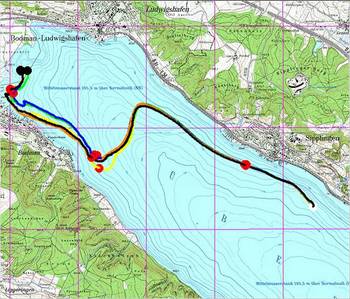
Messung der grossskaligen Zirkulation im Bodensee als Basis für ein Modellsystem zur Beschreibung von Schadstofftransport: Drifterexperimente und Modellvergleich
The project combines field measurements and numerical simulations of the current field in Lake Constance. On the one hand, the large scale circulation in Lake Constance will be measured during different seasons and for different density stratifications of the water column. The field work will provide an empirical basis for the evaluation of the performance of numerical models and for crisis management after accidents with hazardous substances. On the other hand simulations of the velocity field in Lake Constance obtained from three different 3-dimensional numerical models operating under the same forcing and initial conditions will be compared with each other and with the data collected. The intension of this work is to investigate which of the models is most suitable to describe the hydrodynamic conditions at certain stratification and weather conditions. In case of an accident the results from the model comparison will provide a basis for the decision on the model that should be used to describe the spread of the pollutant under the actual environmental conditions. This aspect of the project is closely connected to the project the BMBF/DFG project BodenseeOnline, in which an on-line data collection, data processing and modelling system is being established for crisis management and prognosis of hydrodynamic and bio-geochemical conditions in Lake Constance. The modeling work in the BWPLUS project will be conducted in collaboration with BodenseeOnline and with Lars Umlauf of the IOW.
This is a joint research project coordinated by Frank Peeters (Limnological Institute, University of Konstanz) and by Thomas Wolf (Institut für Seenfoschung, ISF, LUBW).
